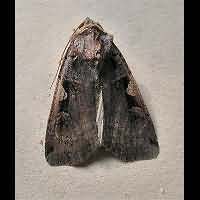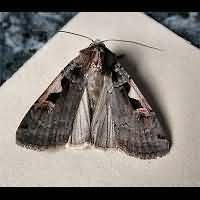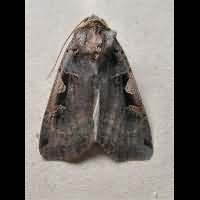Setaceous Hebrew Character Xestia c-nigrum
The Setaceous Hebrew Character is similar in shape to the other Rustics and Clays. But its markings make it standing out and rather easy to identify. It has a dark greyish basic colour usually. Furthermore it has a distinct and striking black C-marking on the wing. The open space of the C however is not round, but has a rather triangular shape. The open space is yellow or even pinkish. And these yellowish triangles are unique for the Setaceous Hebrew Character. Even its doppelgänger the Hebrew Character lacks these light triangles. It actually has a more rounded C too. And don't worry too much about this species. They normally don't fly at the same time much, for usually the Hebrew Character stops flying when the Setaceous Hebrew Character starts to. Reaching a wingspan of 35 to 45mm the Setaceous Hebrew Character is the biggest of the two, but there is a great deal of overlap.
Eggs are being laid all summer and most of autumn. They are deposited individually, but usually not far from eachother on leaves of the hostplant, or on the ground very close to the foodplants. They need only nine days to hatch. Caterpillars hatching in early summer will provide the second generation. Larvae hatching later will overwinter as such. They may even be active in mild winternights. They feed by night only and hide in the foodplant close to the earth during the night. Pupation takes place underground in a loose cocoon. The caterpillar itself is greyish or even blueish brown. On the back is a line consisting of a double row of short, thick, black lines. These are getting balder towards the tail. Under the spiracula is a broad yellow line. The head is lightbrown with darkbrown markings. The caterpillars will reach a length of some 37mm. The food plants are numerous low growing plants, often ones growing together in dense patches, such as nettles and blueberries.
The Setaceous Hebrew Character flies by night only. It is a frequent visitor of gardens, where it is often seen on Buddleija en Ivy. In the south of Britain two generations: May to July and late August to October. In Scotland and farther north single brooded and on the wing from early July to the end of August. In Holland, Belgium and the north of France three generations a year, which means this species is on the wing from the beginning of April to the beginning of November. In the Mediterranean four or possibly five generations and on the wing all year round. Is attracted to light and sugar, but in small numbers only. Easily photographed during daylight. Even permits manipulation to a certain extend. Common all over the British Isles, including Orkney and Shetland. On the continent just as common.
The Setaceous Hebrew Character is similar in shape to the other Rustics and Clays. But its markings make it standing out and rather easy to identify. It has a dark greyish basic colour usually. Furthermore it has a distinct and striking black C-marking on the wing. The open space of the C however is not round, but has a rather triangular shape. The open space is yellow or even pinkish. And these yellowish triangles are unique for the Setaceous Hebrew Character. Even its doppelgänger the Hebrew Character lacks these light triangles. It actually has a more rounded C too. And don't worry too much about this species. They normally don't fly at the same time much, for usually the Hebrew Character stops flying when the Setaceous Hebrew Character starts to. Reaching a wingspan of 35 to 45mm the Setaceous Hebrew Character is the biggest of the two, but there is a great deal of overlap.
Eggs are being laid all summer and most of autumn. They are deposited individually, but usually not far from eachother on leaves of the hostplant, or on the ground very close to the foodplants. They need only nine days to hatch. Caterpillars hatching in early summer will provide the second generation. Larvae hatching later will overwinter as such. They may even be active in mild winternights. They feed by night only and hide in the foodplant close to the earth during the night. Pupation takes place underground in a loose cocoon. The caterpillar itself is greyish or even blueish brown. On the back is a line consisting of a double row of short, thick, black lines. These are getting balder towards the tail. Under the spiracula is a broad yellow line. The head is lightbrown with darkbrown markings. The caterpillars will reach a length of some 37mm. The food plants are numerous low growing plants, often ones growing together in dense patches, such as nettles and blueberries.
The Setaceous Hebrew Character flies by night only. It is a frequent visitor of gardens, where it is often seen on Buddleija en Ivy. In the south of Britain two generations: May to July and late August to October. In Scotland and farther north single brooded and on the wing from early July to the end of August. In Holland, Belgium and the north of France three generations a year, which means this species is on the wing from the beginning of April to the beginning of November. In the Mediterranean four or possibly five generations and on the wing all year round. Is attracted to light and sugar, but in small numbers only. Easily photographed during daylight. Even permits manipulation to a certain extend. Common all over the British Isles, including Orkney and Shetland. On the continent just as common.







